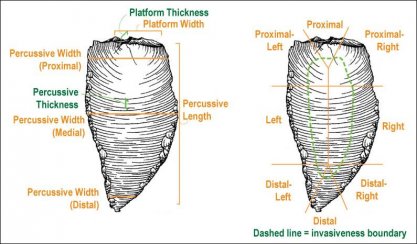Phase II Lithics Analysis
The lithics analysis conducted by A. Mackay, S. Morales, and N. Tripcevich is largely based on a modified version of the lithics analysis strategies that Mackay employs in projects at Australian National University under the direction of Dr. Peter Hiscock. This methodology was tailored to meet the needs of the Upper Colca project and to be comparable with lithics analysis in Andes that often have a more typological orientation.
During Phase II lithics analysis, the following measures were taken when possible. A custom MS Access form was designed for the Phase II lithics analysis that functioned with digital calipers to expedite gathering metric attributes digitally.
|
Name |
Description |
Illustrated |
|
Material |
Obsidian, Chert, Chalcedony, Fine-grained Volcanics (Rhyolite, Andesite, Basalt), Quartzite, Fine-grained siliceous, Igneous |
|
|
Class and Type |
Flake, core, heat shatter, hammerstone, groundstone, non-diagnostic fragment (NDF). Projectile Point, biface, retouched flake, perforator. |
|
|
Color / Shade |
Shades of obsidian: Black, white, clear, clear-banded, grey, grey-banded, brown, brown_banded. Other material types also included: red, black-orange, black-tan, olive, orange, pink, red-blue, red-brown, cream, white-tan, white-pink. |
|
|
Weight (g) |
||
|
Complete |
True/False |
|
|
Transverse snaps |
Proximal, medial, distal - referring to existing segment. |
|
|
Longitudinal snaps |
Left or right - referring to existing segment |
|
|
Percussive Metrics |
Distance from Point of initiation to termination |
Yes |
|
Percussive Width |
[Proximal, Medial, Distal] Distance across flake at 90 to force of application |
Yes |
|
Percussive Thickness |
Distance from ventral to dorsal at midpoint of percussive length and percussive width (medial) |
Yes |
|
Platform width |
Lateral distance across platform |
Yes |
|
Platform thickness |
Distance across platform from dorsal to ventral |
Yes |
|
Platform preparation |
Presence of overhang removal, faceting, or both (Whittaker 1994: 101) |
|
|
Platform angle |
Angle formed by intersection of platform and dorsal face. |
|
|
Cortex percentage |
% of cortex coverage in increments of 10. Flakes: dorsal and platform only, cores: whole piece. |
|
|
Cortex location |
On flakes: Dorsal, platform or both. |
|
|
Cortex type |
Rounded, tubular, irregular, |
|
|
Heat affected |
Y/N |
|
|
Heat Type |
Greasy luster, crazing, pot-lidding, shatter |
|
|
Termination type |
Feather, hinge, step, plunging (outre-passé) |
|
|
Number of dorsal flake scars |
Number of clear (with initation, termination or both) flake scars on dorsal surface of flake |
|
|
Number of rotations |
N-1 where N is the total number of different directions from which previous flakes have been struck, sensu Clarkson et al. (2006). Increments of 45°. |
|
|
Retouched |
Y/N |
|
|
Retouch Type |
Dorsal Ventral, both |
|
|
# of retouched segments |
Flake divided into 8 segments |
Yes |
|
Retouch data |
P, PL, PR, ML, MR, DL, DR, D: Degree and Angle of Retouch for each. Marginal = .5, Invasive = 1 following Clarkson (2002). |
Yes |
Table 5-8. Measures on flaked stone artifacts during Phase II lithics analysis with measures depicted in Figure 5-9 indicated in "Illustrated" column.
Figure5-9. Showing some of the percussive metrics, platform metrics, and measures of retouch invasiveness for ventral side (Clarkson 2002) used in the Phase II analysis. Dorsal features and platform angle not shown.
Metric measures (shown in Table 5-6 and Figure 5-9) were taken with digital calipers accurate to 0.01 mm. The percussive length measure, rather than total a flake length measure, was used. Approximately 3,050 flakes were analyzed with these criteria.

